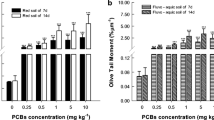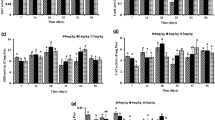Abstract
Earthworm toxicity assays contribute to ecological risk assessment and consequently standard toxicological endpoints, such as mortality and reproduction, are regularly estimated. These endpoints are not enough to better understand the mechanism of toxic pollutants. We employed an additional endpoint in the earthworm Eisenia andrei to estimate the pollutant-induced stress. In this study, comet assay was used as an additional endpoint to evaluate the genotoxicity of weathered hydrocarbon contaminated soils containing 520 to 1450 mg hydrocarbons kg−1 soil. Results showed that significantly higher DNA damage levels (two to sixfold higher) in earthworms exposed to hydrocarbon impacted soils. Interestingly, hydrocarbons levels in the tested soils were well below site-specific screening guideline values. In order to explore the reasons for observed toxicity, the contaminated soils were leached with rainwater and subjected to earthworm tests, including the comet assay, which showed no DNA damage. Soluble hydrocarbon fractions were not found originally in the soils and hence no hydrocarbons leached out during soil leaching. The soil leachate’s Electrical Conductivity (EC) decreased from an average of 1665 ± 147 to 204 ± 20 µS cm−1. Decreased EC is due to the loss of sodium, magnesium, calcium, and sulphate. The leachate experiment demonstrated that elevated salinity might cause the toxicity and not the weathered hydrocarbons. Soil leaching removed the toxicity, which is substantiated by the comet assay and soil leachate analysis data. The implication is that earthworm comet assay can be included in future eco (geno) toxicology studies to assess accurately the risk of contaminated soils.





Similar content being viewed by others
References
Alexander M (2000) Aging, bioavailability, and overestimation of risk from environmental pollutants. Environ Sci Technol 34:4259–4265. doi:10.1021/es001069+
Bispo A, Jourdain MJ, Jauzein M (1999) Toxicity and genotoxicity of industrial soils polluted by polycyclic aromatic hydrocarbons (PAHs). Org Geochem 30:947–952
Bonnard M, Eom IC, Morel JL, Vasseur P (2009) Genotoxic and reproductive effects of an industrially contaminated soil on the earthworm Eisenia fetida. Environ Mol Mut 50:60–67
Brils JM, Huwer SL, Kater BJ, Schout PG, Harmsen J, Delvigne GA, Scholten MCT (2002) Oil effect in freshly spiked marine sediment on Vibrio fischeri, Corophium volutator, and Echinocardium cordatum. Environ Toxicol Chem 21:2242–2251
Button M, Jenkin GR, Bowman KJ, Harrington CF, Brewer TS, Jones GD, Watts MJ (2010) DNA damage in earthworms from highly contaminated soils: assessing resistance to arsenic toxicity by use of the Comet assay. Mut Res Gen Toxicol Environ Mut 696:95–100
Chapman H, Huston R, Gardner T, Chan A, Shawl G Chemical water quality and health risk assessment of urban rainwater tanks. In: 7th international conference on urban drainage modelling and the 4th international conference on water sensitive urban design; Book of Proceedings, 2006. Monash University, p 509
Čvančarová M, Křesinová Z, Cajthaml T (2013) Influence of the bioaccessible fraction of polycyclic aromatic hydrocarbons on the ecotoxicity of historically contaminated soils. J Hazard Mat 254–255:116–124. doi:10.1016/j.jhazmat.2013.03.060
de Lapuente J, Lourenço J, Mendo SA, Borràs M, Martins MG, Costa PM, Pacheco M (2015) The Comet Assay and its applications in the field of ecotoxicology: a mature tool that continues to expand its perspectives. Frontiers Genet 6:180
Dhainaut A, Scaps P (2001) Immune defense and biological responses induced by toxics in Annelida. Can J Zool 79:233–253
Dhawan A, Bajpayee M, Parmar D (2009) Comet assay: a reliable tool for the assessment of DNA damage in different models. Cell Biol Toxicol 25:5–32
Di Marzio WD, Saenz ME, Lemière S, Vasseur P (2005) Improved single-cell gel electrophoresis assay for detecting DNA damage in Eisenia foetida. Environ Mol Mut 46:246–252
Di Toro DM, McGrath JA, Stubblefield WA (2007) Predicting the toxicity of neat and weathered crude oil: toxic potential and the toxicity of saturated mixtures. Environ Toxicol Chem 26:24–36
Dorn PB, Salanitro JP (2000) Temporal ecological assessment of oil contaminated soils before and after bioremediation. Chemosphere 40:419–426
Dorn PB, Vipond TE, Salanitro JP, Wisniewski HL (1998) Assessment of the acute toxicity of crude oils in soils using earthworms, microtox and plants. Chemosphere 37:845–860
Duan L, Naidu R, Thavamani P, Meaklim J, Megharaj M (2015) Managing long-term polycyclic aromatic hydrocarbon contaminated soils: a risk-based approach. Environ Sci Poll Res 22:8927–8941. doi:10.1007/s11356-013-2270-0
Echols BS, Smith A, Gardinali P, Rand G (2016) An evaluation of select test variables potentially affecting acute oil toxicity. Arch Environ Contam Toxicol 70:392–405
Eom I, Rast C, Veber A, Vasseur P (2007) Ecotoxicity of a polycyclic aromatic hydrocarbon (PAH)-contaminated soil. Ecotoxicol Environ Saf 67:190–205
Espinosa-Reyes G et al (2010) DNA damage in earthworms (Eisenia spp.) as an indicator of environmental stress in the industrial zone of Coatzacoalcos, Veracruz, Mexico. J Environ Sci Health A 45:49–55
Eyambe GS, Goven AJ, Fitzpatrick L, Venables BJ, Cooper EL (1991) A non-invasive technique for sequential collection of earthworm (Lumbricus terrestris) leukocytes during subchronic immunotoxicity studies. Lab Anim 25:61–67
Frampton GK, Jänsch S, Scott-Fordsmand JJ, Römbke J, Van den Brink PJ (2006) Effects of pesticides on soil invertebrates in laboratory studies: a review and analysis using species sensitivity distributions. Environ Toxicol Chem 25:2480–2489
Guerin TF (2002) Heavy equipment maintenance wastes and environmental management in the mining industry. J Environ Manag 66:185–199
Hanna SHS, Weaver R (2002) Earthworm survival in oil contaminated soil. Plant Soil 240:127–132
Jonker MT, Brils JM, Sinke AJ, Murk AJ, Koelmans AA (2006) Weathering and toxicity of marine sediments contaminated with oils and polycyclic aromatic hydrocarbons. Environ Toxicol Chem 25:1345–1353
Juhasz AL, Smith E, Waller N, Stewart R, Weber J (2010) Bioavailability of residual polycyclic aromatic hydrocarbons following enhanced natural attenuation of creosote-contaminated soil. Environ Pollut 158:585–591
Klobučar GIV, Štambuk A, Šrut M, Husnjak I, Merkaš M, Traven L, Cvetković Ž (2011) Aporrectodea caliginosa, a suitable earthworm species for field based genotoxicity assessment? Environ Pollut 159:841–849. doi:10.1016/j.envpol.2011.01.009
Kumaravel T, Jha AN (2006) Reliable Comet assay measurements for detecting DNA damage induced by ionising radiation and chemicals. Mut Res Gen Toxicol Environ Mut 605:7–16
Lanno R, Wells J, Conder J, Bradham K, Basta N (2004) The bioavailability of chemicals in soil for earthworms. Ecotoxicol Environ Saf 57:39–47
Li M, Liu Z, Xu Y, Cui Y, Li D, Kong Z (2009) Comparative effects of Cd and Pb on biochemical response and DNA damage in the earthworm Eisenia fetida (Annelida, Oligochaeta). Chemosphere 74:621–625
Lionetto MG, Calisi A, Schettino T (2012) Earthworm biomarkers as tools for soil pollution assessment. Soil health and land use management, InTech-Open Access Publisher in Science, Technology and Medicine, Rijeka (Croatia), pp 305–332
Manerikar RS, Apte AA, Ghole VS (2008) In vitro and in vivo genotoxicity assessment of Cr(VI) using comet assay in earthworm coelomocytes. Environ Toxicol Pharmacol 25:63–68
Naidu R et al (2013) Towards bioavailability-based soil criteria: past, present and future perspectives. Environ Sci Poll Res 1–7
Neff JM, Ostazeski S, Gardiner W, Stejskal I (2000) Effects of weathering on the toxicity of three offshore Australian crude oils and a diesel fuel to marine animals. Environ Toxicol Chem 19:1809–1821
NEPC (2011) National Environment Protection (Assessment of Site Contamination) Measure http://www.scew.gov.au/archive/site-contamination/pubs/asc-nepm/schedule_b1__guideline_on_investigation_levels_for_soil_and_groundwater__sep10.pdf
Neri M, Milazzo D, Ugolini D, Milic M, Campolongo A, Pasqualetti P, Bonassi S (2015) Worldwide interest in the comet assay: a bibliometric study. Mutagenesis 30:155–163
O’Reilly KT, Magaw RI, Rixey WG (2001) Predicting the effect of hydrocarbon and hydrocarbon-impacted soil on groundwater. Am Petrol Inst 14
Oboh B, Adeyinka Y, Awonuga S, Akinola M (2007) Impact of soil types and petroleum effluents on the earthworm. Eudrilus eugeniae, J Environ Biol, p 28
OECD (2004) OECD guidelines for testing chemicals. Method 222, Earthworm reproduction test (Eisenia fetida/Eisenia Andrei). Paris, France
Owojori O, Reinecke A, Voua-Otomo P, Reinecke S (2009) Comparative study of the effects of salinity on life-cycle parameters of four soil-dwelling species (Folsomia candida, Enchytraeus doerjesi, Eisenia fetida and Aporrectodea caliginosa). Pedobiologia 52:351–360
Piola L, Fuchs J, Oneto ML, Basack S, Kesten E, Casabé N (2013) Comparative toxicity of two glyphosate-based formulations to Eisenia andrei under laboratory conditions. Chemosphere 91:545–551
Plaza G, Nalecz-Jawecki G, Ulfig K, Brigmon RL (2005) The application of bioassays as indicators of petroleum-contaminated soil remediation. Chemosphere 59:289–296
Qiao M, Chen Y, Wang C-X, Wang Z, Zhu Y-G (2007) DNA damage and repair process in earthworm after in vivo and in vitro exposure to soils irrigated by wastewaters. Environ Pollut 148:141–147
Rajaguru P, Kalaiselvi K, Palanivel M, Subburam V (2000) Biodegradation of azo dyes in a sequential anaerobic–aerobic system. Appl Microbiol Biotechnol 54:268–273
Ramadass K, Smith E, Palanisami T, Mathieson G, Srivastava P, Megharaj M, Naidu R (2015) Evaluation of constraints in bioremediation of weathered hydrocarbon-contaminated arid soils through microcosm biopile study. Int J Environ Sci Technol 12:3597–3612
Robidoux PY et al (2000) Chronic toxicity of energetic compounds in soil determined using the earthworm (Eisenia andrei) reproduction test. Environ Toxicol Chem 19:1764–1773
Salagovic J, Gilles J, Verschaeve L (1996) The comet assay for the detection of genotoxic damage in the earthworms: a promising tool for assessing the biological hazards of polluted sites. Folia Biol 42:17–21
Salanitro JP et al (1997) Crude oil hydrocarbon bioremediation and soil ecotoxicity assessment. Environ Sci Technol 31:1769–1776
Sanchez-Hernandez J (2006) Earthworm biomarkers in ecological risk assessment. In: Reviews of environmental contamination and toxicology. Springer, New York, pp 85–126
Schaefer M (2003) Behavioural endpoints in earthworm ecotoxicology. J Soils Sed 3:79–84
Shastri S, Kamper S, Sonigra T, Hill T, Beales J (2012) Australia’s Mining Thirst. GTL Solution, Mumbai
Shin KH, Jung H, Chang P, Choi H, Kim KW (2005) Earthworm toxicity during chemical oxidation of diesel-contaminated sand. Environ Toxicol Chem 24:1924–1929
Singh NP, McCoy MT, Tice RR, Schneider EL (1988) A simple technique for quantitation of low levels of DNA damage in individual cells. Exp Cell Res 175:184–191
Smit MG et al (2009) Relating biomarkers to whole-organism effects using species sensitivity distributions: a pilot study for marine species exposed to oil. Environ Toxicol Chem 28:1104–1109
Speit G, Vasquez M, Hartmann A (2009) The comet assay as an indicator test for germ cell genotoxicity. Mut Res 681:3
Tang J, Wang M, Wang F, Sun Q, Zhou Q (2011) Eco-toxicity of petroleum hydrocarbon contaminated soil. J Environ Sci 23:845–851. doi:10.1016/s1001-0742(10)60517-7
Thavamani P, Smith E, Kavitha R, Mathieson G, Megharaj M, Srivastava P, Naidu R (2015) Risk based land management requires focus beyond the target contaminants: a case study involving weathered hydrocarbon contaminated soils. Environ Technol Innov 4:98–109. doi:10.1016/j.eti.2015.04.005
van Gestel CAM, van Dis WA (1988) The influence of soil characteristics on the toxicity of four chemicals to the earthworm Eisenia fetida andrei (Oligochaeta). Biol Fertil Soils 6:262–265. doi:10.1007/bf00260822
Van Gestel CAM, Van Dis WA, Van Breemen EM, Sparenburg PM (1989) Development of a standardized reproduction toxicity test with the earthworm species Eisenia fetida andrei using copper, pentachlorophenol, and 2,4-dichloroaniline. Ecotox Environ Saf 18:305–312
Zang Y, Zhong Y, Luo Y, Kong Z (2000) Genotoxicity of two novel pesticides for the earthworm, Eisenia fetida. Environ Pollut 108:271–278
Acknowledgments
This research was supported by the Project funded by Cooperative Research Centre for Contamination Assessment and Remediation of the Environment (CRC CARE).
Author information
Authors and Affiliations
Corresponding author
Rights and permissions
About this article
Cite this article
Ramadass, K., Palanisami, T., Smith, E. et al. Earthworm Comet Assay for Assessing the Risk of Weathered Petroleum Hydrocarbon Contaminated Soils: Need to Look Further than Target Contaminants. Arch Environ Contam Toxicol 71, 561–571 (2016). https://doi.org/10.1007/s00244-016-0318-0
Received:
Accepted:
Published:
Issue Date:
DOI: https://doi.org/10.1007/s00244-016-0318-0




